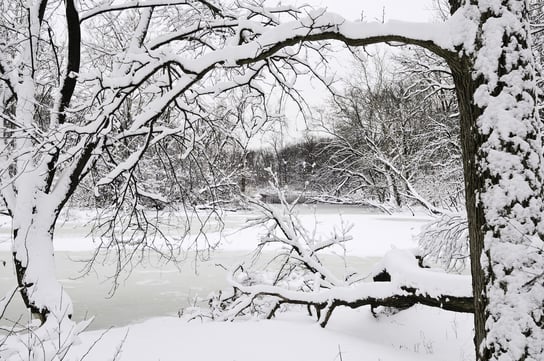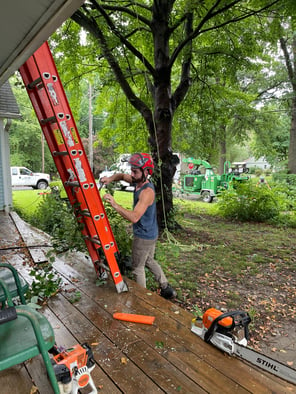Winter is a magical time for trees, and with a sprinkle of care, your leafy friends can weather the chill with grace. Here are some delightful winter tree care tips for Kansas City homeowners that you can easily handle on your own. And remember, for the high-reaching branches that need a bit more love, Cartwright Tree Care is just a call away!
Winter Watering Wisdom:
Watering your trees in the winter in the Midwest is a surprisingly crucial practice for ensuring the well-being of your leafy companions. Despite the cold temperatures and the presence of snow, trees can experience dehydration during winter. The winter air can be dry, and the combination of winter sun and wind may lead to a phenomenon known as "winter desiccation," where the tree loses more water through its leaves than it can absorb from the frozen ground. Providing water in winter helps mitigate this stress and enhances the overall winter hardiness of your trees.
The hydration of tree roots is essential even during dormancy, allowing them to continue absorbing nutrients and sustaining the tree's health. This becomes especially important for evergreen trees, as their needles can lose moisture through transpiration even when the ground is frozen. Well-hydrated trees are more resilient to freezing temperatures, contributing to their ability to endure the cold without suffering damage. Additionally, winter watering sets the stage for the rapid growth that comes with the arrival of spring, ensuring that your tree is prepared to burst forth with new leaves and blooms.
Overall, winter watering is a strategic and essential component of tree care, safeguarding your landscape investment and promoting the long-term vitality of your trees.
- What to Do: Give your trees a cozy sip of water during dry spells.
- Why: Just like you need a drink to stay cozy in winter, so do your trees!
Mulching Magic:
Mulching your trees in the winter is a vital practice that contributes to the overall health and well-being of your leafy companions. While it may seem like an activity reserved for warmer seasons, mulching in winter offers unique benefits. First and foremost, a fresh layer of mulch acts as a cozy blanket for the soil, providing insulation that helps regulate soil temperature. This is particularly crucial in the Midwest, where winter temperatures can fluctuate. The mulch serves as a protective barrier, preventing extreme temperature variations that can stress tree roots.
Furthermore, mulching acts as a moisture retention agent, helping the soil retain water during the winter months. In cold weather, the ground may freeze, making it challenging for trees to access water. Mulch acts as a reservoir, allowing the soil to maintain a consistent level of moisture. This is especially important for evergreen trees, which can continue losing water through transpiration even in winter.
Beyond its practical benefits, mulching is like a stylish accessory for your trees, adding visual appeal to your winter landscape. The contrast of the dark mulch against the white snow creates a picturesque scene, turning your backyard into a winter wonderland.
So, mulching in winter is not just about practicality; it's about providing your trees with a cozy environment, protecting their roots, and enhancing the aesthetic charm of your outdoor space during the colder months.
- What to Do: Tuck your trees in with a fresh layer of mulch.
- Why: Mulch acts as a warm blanket, keeping the roots snug and stylish

Observing, Not Disturbing:
Resisting the urge to shake branches or disturb the snowy serenity in winter is crucial for maintaining the health and well-being of your trees. As the winter landscape transforms into a serene white wonderland, it's tempting to interact with the snow-covered branches.
However, shaking or disturbing the branches can have adverse effects on the tree. Snow acts as a protective layer, providing insulation to the branches against the cold temperatures. Disturbing this layer can expose the tree to the harsh elements and disrupt its natural defense mechanisms.
Additionally, the weight of snow on branches is carefully balanced, and shaking can lead to breakage or damage. By resisting the urge to intervene, you allow your trees to gracefully navigate the winter season, preserving their beauty and ensuring their resilience in the face of winter challenges. It's a gesture of respect for nature's winter artistry and an acknowledgment of the intricate balance that exists in the snowy landscape.
- What to Do: Resist the urge to shake branches or disturb the snowy serenity.
- Why: Let the winter magic unfold at its own pace, like a natural dance.
Winter Tree Checkup:
Keeping an eye out for signs of stress, such as droopy limbs, is a vigilant and caring practice during the winter months. As you observe your trees in the colder season, pay attention to any unusual changes in the appearance of the branches. Drooping or sagging limbs can be indicative of various issues, including dehydration, pest infestations, or structural problems. Look for discoloration, unusual wilting, or an overall lack of vitality in the branches.
-
Drooping or Sagging Limbs: Observe the overall posture of your tree's branches, as drooping or sagging limbs can indicate stress or structural issues.
-
Discoloration: Keep an eye out for any unusual changes in the color of leaves or needles. Discoloration can be a sign of nutrient deficiencies, pests, or diseases.
-
Unusual Wilting: Notice if there is excessive wilting or lack of turgidity in the branches. This could be a sign of water stress or other underlying problems.
-
Bare Patches: Look for areas where leaves or needles are sparse or absent, as this may indicate localized issues such as pest infestations or diseases.
-
Bark Abnormalities: Check the bark for any unusual patterns, discoloration, or lesions. Changes in the bark can be indicative of various issues affecting the tree's health.
If you notice any concerning signs, it's advisable to reach out to Cartwright Tree Care, your trusted tree care professionals. Our experienced team can conduct a thorough assessment, identifying the root cause of the stress and recommending appropriate solutions.
Winter stress can compromise the overall health of your trees, and timely intervention is key to their well-being. Rather than attempting DIY remedies, calling a professional ensures that your trees receive expert care, tailored to their specific needs. It's a proactive step in preserving the beauty and longevity of your trees, ensuring they thrive through the winter and beyond.
- What to Do: Keep an eye out for signs of stress, like droopy limbs.
- Why: Early detection means you can address issues before they become winter dramas.
Dormancy Celebrations:
Appreciating your tree's dormancy can be transformed into a delightful family activity, turning the winter season into a time of shared wonder and exploration. Encourage your family to embark on a winter scavenger hunt around your yard, discovering the unique characteristics of dormant trees.
Take a moment to observe the intricate patterns of frost on the branches or explore the different textures of bark. Engage in a winter photography session, capturing the beauty of your sleeping trees in various angles and lighting conditions. Consider turning your observations into a family art project, creating winter-themed drawings or paintings inspired by the dormant trees.
Additionally, involve your little ones in a storytelling session, imagining whimsical tales about the adventures your trees embark on during their well-deserved winter nap. Embracing your tree's dormancy becomes not just a moment of quiet observation but a lively family affair, fostering a deeper connection with nature and creating lasting memories in the winter wonderland of your backyard.
-
Winter Scavenger Hunt: Organize a family scavenger hunt around your yard to discover unique characteristics of dormant trees, such as frost patterns and textures of bark.
-
Winter Photography Session: Engage in a family photography session, capturing the beauty of dormant trees from various angles and lighting conditions. Turn it into a creative project.
-
Art Exploration: Transform your observations into an art project. Create winter-themed drawings or paintings inspired by the dormant trees. Encourage each family member to express their creativity.
-
Storytelling Adventure: Gather around and weave imaginative tales about the adventures your trees embark on during their well-deserved winter nap. Let each family member contribute to the story.
-
Nature Journaling: Keep a family nature journal to document the changes in your trees throughout the winter. Include sketches, notes, and observations, creating a shared keepsake of the season.
-
Bird Watching: Set up bird feeders near your dormant trees and enjoy bird watching as local wildlife finds refuge and sustenance among the branches.
- What to Do: Appreciate your tree's dormancy – it's their well-deserved winter nap.
- Why: They're rejuvenating for the vibrant burst of life that comes with spring.
Leave the Ladder to the Pros:
 Hiring Cartwright Tree Care for trimming that requires a ladder is a wise and practical choice that ensures the safety and well-being of your trees. When it comes to reaching higher branches or intricate trimming tasks, our experienced team of professionals is equipped with the right tools, skills, and safety measures. Climbing ladders to trim trees can pose risks, both to individuals attempting the task and to the trees themselves if not done correctly.
Hiring Cartwright Tree Care for trimming that requires a ladder is a wise and practical choice that ensures the safety and well-being of your trees. When it comes to reaching higher branches or intricate trimming tasks, our experienced team of professionals is equipped with the right tools, skills, and safety measures. Climbing ladders to trim trees can pose risks, both to individuals attempting the task and to the trees themselves if not done correctly.
Our experts are trained to assess the specific needs of each tree, applying the appropriate trimming techniques to enhance its health and aesthetics. By entrusting Cartwright Tree Care with ladder-required trimming, you not only ensure the job is done efficiently and safely, but you also contribute to the long-term vitality and beauty of your trees. It's a decision that prioritizes expertise and care, making certain that your trees receive the attention they deserve.
- What to Do: Hire Cartwright Tree Care for trimming that requires a ladder.
- Why: We've got the heights covered, and you can enjoy the show from below!
Remember, your role in winter tree care is like being a caretaker for a whimsical winter wonderland. So, grab your winter gear, step into your backyard, and let's make this winter a magical season for your trees! 🌳❄️✨


